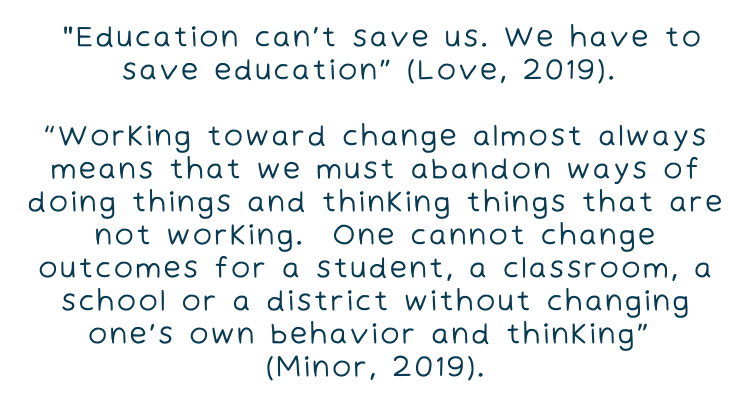
When we think about going back to school in the fall, we as teachers have a vital role to play in going back to better. “Normal” did not serve a great number of children and as countless educators have said, we have to go back to better.
Independent reading is the right of every student, yet we know that too many students are not given access to this opportunity with regularity. Curricular demands and biased assumptions about the needs and abilities of students are often to blame for this inequity. We can disrupt this inequity.
There is an astounding amount of research that illustrates the benefits of independent reading. Independent reading not only supports students in their growth as readers, it has the potential to set them up for a lifetime of reading as well as contribute to the development of empathy and social comprehension. In other words, independent reading isn’t just worth it, it should be the centerpiece of literacy instruction.
Teachers have the ability each year to make our classrooms spaces of new possibilities. We urge you to reflect on and imagine what is possible for independent reading in your classroom when you consider three key elements: engagement, reading identity, and trust.
The Element of Engagement in Independent Reading
Engagement is the ultimate goal for our readers. When students are engaged in their reading, they are transferring their learning into independence to make meaning from text. Engagement in learning is one of the major contributors to student achievement (Fisher, Frey & Quaglia, 2018). The work of Ellin Oliver Keene (2018), offers ways to understand various ways to invite engagement as well as clear ways to talk about it alongside our students. Standing on the shoulders of Keene’s work, we define student engagement as existing along a continuum that includes disengagement, compliance, and engagement. Our role is to ensure that we create both a classroom environment and a wealth of opportunities that invite our students to engage with texts.
Engagement is when our students enter a state of flow; they are so immersed in reading that they organically call into action all they have learned about the work of readers with a clear sense of purpose. This does not happen with jazz hands, treasure boxes, or accountability mechanisms designed solely to “prove” that students are “reading.” Understanding and growth do not stem from answering prescribed questions, having a certain number of sticky notes, or filling out reading logs.
One clear way to consistently invite engagement into independent reading is to provide students with choice. With choice, students have the space to explore, construct, and expand their identities as readers.
In what ways do you already offer choice to your students during independent reading? How might you push choice further to create new and different invitations for your students to engage? Consider some of the following options to embrace the power of choice:
- Students choose their own texts from a wide range of inclusive options
- Students choose collectively how to organize and expand the classroom library
- Students choose where to read, with whom and for what purpose
- Students choose when and how to authentically respond to text
- Students choose how to represent and share their identities as readers with others
- Students sign up for conferences
Inspiring children to be more engaged with their reading is an essential step to going back to better independent reading. By developing trust through close relationships with students, teachers have the knowledge and opportunity to create the conditions for increased engagement.
We trust that all students can be engaged.

The Element of Reading Identity as a Starting Point for Instruction
Reading identity and reading engagement have a reciprocal relationship; when a student feels confident in their reading identity, they are more likely to be deeply engaged in their reading. In turn, being deeply engaged with text naturally leads to a stronger positive sense of reading identity. In order for teachers to create relevant opportunities for students to be engaged as readers, they need to devote time to get to know and re-know students’ identities as readers.
We conceive of a student’s reading identity not as static, but as always developing. As the student has different reading experiences across a school year, their reading identity evolves. We define reading identity as consisting of five key aspects: attitude, self-efficacy, habits, book choice and process.
As teachers, our job is to synthesize what we know about a student from kid watching, anecdotal notes and various assessments to begin to create a picture of that student as a reader. Yet this information alone does not truly tell us about a student's identity as a reader. Therefore, our most important job is to listen as we provide space for students to construct and re-construct their own identities as readers throughout the school year.
A student’s reading identity intersects with their larger identity as a person. Therefore, coming to know a student involves much more than the data collected. Factors such as a student’s race, gender, class, and ability play a vital role in how students’ select books, set purposes for reading, and interact with the text. By striving to know a more complete story of the student as a reader and as a person throughout the school year, teachers are better positioned to create invitations for reading that are authentic and relevant.
In what ways do you strive to learn the story of your readers during independent reading? How can you support your readers throughout the year as they construct and re-construct these identities? Here are some ways to learn the stories of readers and support them in sharing them with one another:
- Host regular reading conferences one-on-one with students.
- Devote time to learning about and connecting with your students’ lives beyond school.
- Offer multi-modal opportunities for students to share aspects of their reading identities and/or larger identities.
- Create fresh reading partnerships using aspects of student reading identity as a guide.
- Invite members of the school community to talk about their identities as readers.
We trust that all students are readers.
The Element of Trust in Independent Reading
In the first few days of the school year, we begin the essential work of developing trusting relationships. If our goal is to learn the stories of our students as readers and people, and to invite students to tell these stories themselves, we must first establish the classroom as a safe space in which trust abounds.
We trust that students in our classrooms are already living their reading lives and with a sense of who they are as readers. Our work is to honor and nurture these reading identities by trusting that students have their own purposes for reading, their own preferences for reading and their own authentic ways to respond to texts. Trusting students to make decisions for their own independent reading from the moment they walk into the classroom (while we sit back to do some kidwatching) is a powerful first step.
In what ways do you work to establish trust during independent reading? How can you trust your students to show and share who they are as readers? Consider the following:
- Give your students independent reading time free of accountability mechanisms designed to ensure compliance.
- Put out a selection of inclusive texts. Allow students to skim, preview or try out various selections as they choose before making any choices.
- Ask student process-oriented questions that emphasize how they interact with text such as: “Why did you pick this one?” “What are you thinking about as you read?” “What are you paying attention to?”
We trust teachers to take on the daily work of building and maintaining trust.
Going Back to Better in Independent Reading
Some of our most essential work is to imagine possibilities for our students and classrooms in the midst of endless demands on our time. We can go back to better by imagining and pursuing what ought to be, rather than feeling obligated to return to the way things were. We trust teachers to imagine these spaces and to teach readers. How can you trust yourself to go back to better independent reading in the coming school year?

To learn more about Trusting Readers, visit Heinemann.com.
You've just read blog #1 in a three-part blog series.
Click below to read Blog #2 and Blog #3.

Dr. Jennifer Scoggin has been a teacher, author, speaker, curriculum writer, and literacy consultant. Jennifer’s interest in the evolving identities of both students and teachers and her growing obsession with children’s literature led her to and informs her work. Jen began her career teaching first and second grades in Harlem, New York. In her current role as a literacy consultant, Jennifer collaborates with teachers to create engaging literacy opportunities for children. She holds a doctorate in curriculum and instruction from Teachers College, Columbia University and has previously published two books about literacy instruction and life in the classroom.

Hannah Schneewind has been a teacher, staff developer, curriculum writer, keynote speaker and national literacy consultant. She brings with her over 25 years of experience to the education world. Hannah’s interest in student and teacher agency and her belief in the power of books informs her work with schools.
Hannah began her career as a first grade teacher at P.S. 321 in Brooklyn, New York, and her classroom was used as a model classroom for teachers around the city and country. The trust the administrators placed in her along with the culture of collaboration in the school formed her beliefs in the power and possibilities of schools.
Together, Jen and Hannah created Trusting Readers, a group dedicated to collaborating with teachers to design literacy opportunities that invite all students to be engaged and to thrive as readers and writers.





